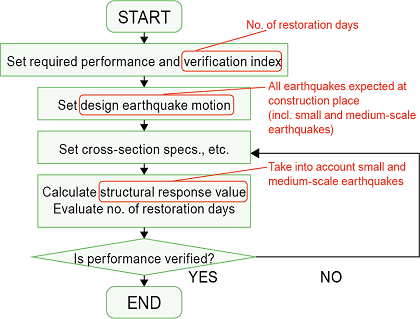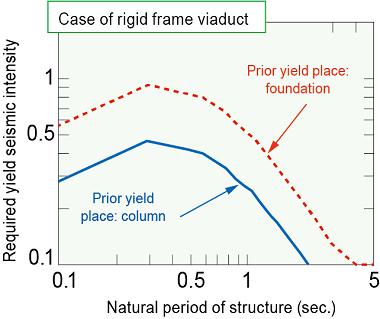3. Method for verifying the restorability of railway structures considering small-and medium-scale earthquakes
Current seismic design of railway structures requires that damage resulting from a large-scale earthquake of seismic intensity 7 (Level 2 seismic motion) is rapidly repairable.
However, the structural performance against medium-scale earthquakes of seismic intensities “6 lower” and “6 upper,” which are occurring frequently in recent years, is not clearly defined.
As a result, some issues have emerged in relation to “rapid” restoration. For example, it took a long time to resume operation after the 2018 northern Osaka Prefecture earthquake and the 2021 northern Chiba Prefecture earthquake.
To solve this problem, we proposed a method for verifying the restorability of structures taking into consideration the effects of small- and medium-scale earthquakes.
A feature of the design flow of the proposed method (Fig. 1) is that it applies to “all seismic motions including small- and medium-scale earthquakes” and that “the number of days required for restoration is used as a verification index.” This method can be directly adopted into frameworks of current seismic design.
To make the design with the proposed method more practicable, a nomogram (Fig. 2) for the required strength (yield seismic intensity) of structures was developed for each of required restoration time, conditions (e.g., region, structural type), and damaged structural parts (e.g., foundation, column).
The results show that to ensure the same level of restorability as a structure with prior column damage, a structure with prior foundation damage requires a higher yield seismic intensity.
In past earthquakes, it takes many days to restore a structure whose foundation has been damaged. This trend is in accordance with the results in Fig. 2. Fig. 2 shows the yield seismic intensity necessary to make a structure restorable in five days, but it is possible to design in the same procedure as usual by selecting the nomogram corresponding to the required number of days for restoration.
The proposed method makes it possible to design new structures that are easier to restore after earthquake damage.
Moreover this method can identify the parts of existing structures that require most time for restoration, so it is possible to shorten the time until operation resumes after an earthquake by applying focused proactive measures to these parts.
Other Contents
- 1. Earthquake early warning method for the earthquake source fault regions
- 2. Design method for bearing parts to control damage and improve restorability
- 3. Method for verifying the restorability of railway structures considering small-and medium-scale earthquakes
- 4. Method for evaluating vehicle safety in strong winds using probabilistic risk assessment
- 5. Inspection of gaps by hammering slab track filling layers and prediction of deterioration
- 6. Method for estimating snow accretion and snow dropping of a train vehicle for investigating countermeasures against snow dropping
- 7. Method of applying image processing-based object detection and obstacle determination to safety applications
- 8. Support system for preventing a decline in alertness level of drivers
- 9. Phased array ultrasonic testing method for easy detection of flaws in bogie frame welds
- 10. Oil for axle-box for Shinkansen with excellent low-temperature performance and maintainability
- 11. Seat surfaces for minimizing injuries to passengers in the event of a collision
- 1. Earthquake early warning method for the earthquake source fault regions
- 2. Design method for bearing parts to control damage and improve restorability
- 3. Method for verifying the restorability of railway structures considering small-and medium-scale earthquakes
- 4. Method for evaluating vehicle safety in strong winds using probabilistic risk assessment
- 5. Inspection of gaps by hammering slab track filling layers and prediction of deterioration
- 6. Method for estimating snow accretion and snow dropping of a train vehicle for investigating countermeasures against snow dropping
- 7. Method of applying image processing-based object detection and obstacle determination to safety applications
- 8. Support system for preventing a decline in alertness level of drivers
- 9. Phased array ultrasonic testing method for easy detection of flaws in bogie frame welds
- 10. Oil for axle-box for Shinkansen with excellent low-temperature performance and maintainability
- 11. Seat surfaces for minimizing injuries to passengers in the event of a collision


